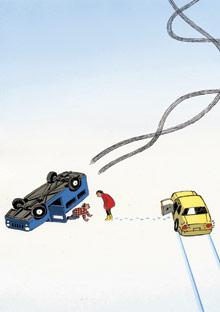Winter Driving 101

Photo Illustration: Guy Billout
Get in the car; make sure the doors are closed. (Check.) Gas in the tank? (Check.) Buckle up. (Double-check.)
So far, so good. But if it's snowing or icy out, now's not the time to sit back and blast the radio while driving on cruise control. "The more slippery the surface, the more important it is to use finesse and timing to control the car," says Mark Cox, director of the Bridgestone Winter Driving School in Steamboat Springs, Colorado. These safe-driving techniques will keep you on the road this winter:
Stopping: The key here is practice. The next time the roads are wet, go to a large, deserted parking lot and then accelerate and stop quickly so you can rehearse "panic braking." If your car has antilock brakes, you will feel them kick in. Resist the urge to take your foot off the brake. "The beauty of an antilock braking system is that pressing the pedal as hard as possible and holding it down allows the computer to pump the brakes but still gives you some steering effectiveness," says Cox. If you have traditional brakes, pump them gently to stop the car; if you press the pedal all the way down, you might skid.
Taking a turn: Slow down before the curve, braking only on the straightaway as you approach. "Then, right before you go into the turn, take your foot off the brake, which allows you to use all the traction available to help steer," says Cox. Accelerate only when you are able to straighten the steering wheel again.
At intersections and on hills: Icy road conditions often worsen as drivers brake in the same places. The ice becomes smooth, polished, and increasingly dangerous. Look for safer areas of road that aren;t so shiny or for fresh snow, which provides better traction. If you;re trying to stop on ice, use more force on the brakes early and then lighten up as the car slows.
When the windshield ices up: In the fall, install a pair of winter windshield wipers—they really make a difference. "I also recommend applying Aquapel, a product that helps keep water and snow from sticking to the glass. One application will last six months or so," says Cox. "You can use de-icing windshield washer fluids or, for the technologically minded, install a windshield washer fluid heater in your car." While driving in a blizzard, he says, pay attention and put the defroster on well before the windshield begins to freeze up. If you;ve waited too long, pull over and let the glass clear before you get back on the road.
To take a defensive driving class, go to AAA.com or ask your auto insurance representative for one in your region. You might even get lower premiums with your improved road skills.
So far, so good. But if it's snowing or icy out, now's not the time to sit back and blast the radio while driving on cruise control. "The more slippery the surface, the more important it is to use finesse and timing to control the car," says Mark Cox, director of the Bridgestone Winter Driving School in Steamboat Springs, Colorado. These safe-driving techniques will keep you on the road this winter:
Stopping: The key here is practice. The next time the roads are wet, go to a large, deserted parking lot and then accelerate and stop quickly so you can rehearse "panic braking." If your car has antilock brakes, you will feel them kick in. Resist the urge to take your foot off the brake. "The beauty of an antilock braking system is that pressing the pedal as hard as possible and holding it down allows the computer to pump the brakes but still gives you some steering effectiveness," says Cox. If you have traditional brakes, pump them gently to stop the car; if you press the pedal all the way down, you might skid.
Taking a turn: Slow down before the curve, braking only on the straightaway as you approach. "Then, right before you go into the turn, take your foot off the brake, which allows you to use all the traction available to help steer," says Cox. Accelerate only when you are able to straighten the steering wheel again.
At intersections and on hills: Icy road conditions often worsen as drivers brake in the same places. The ice becomes smooth, polished, and increasingly dangerous. Look for safer areas of road that aren;t so shiny or for fresh snow, which provides better traction. If you;re trying to stop on ice, use more force on the brakes early and then lighten up as the car slows.
When the windshield ices up: In the fall, install a pair of winter windshield wipers—they really make a difference. "I also recommend applying Aquapel, a product that helps keep water and snow from sticking to the glass. One application will last six months or so," says Cox. "You can use de-icing windshield washer fluids or, for the technologically minded, install a windshield washer fluid heater in your car." While driving in a blizzard, he says, pay attention and put the defroster on well before the windshield begins to freeze up. If you;ve waited too long, pull over and let the glass clear before you get back on the road.
To take a defensive driving class, go to AAA.com or ask your auto insurance representative for one in your region. You might even get lower premiums with your improved road skills.
As a reminder, always consult your doctor for medical advice and treatment before starting any program.



